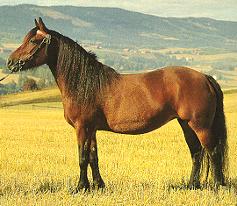Dole Trotter or Dole Gudbrandsdal
N/A
Sat, 23rd November, 2024 - 4:29 am GMT
Sponsor Ads:

Alternative Name
N/ABasic Info
The Døle horse of today is found in two types. A heavy work horse and a light draft horse, the cold-blooded trotter. The difference between the two types has been greatly reduced in recent years due to interbreeding between the types. This interbreeding is now becoming very common and the breed is becoming very uniform.
Health
N/AHabitat
N/ABehavior
The heavy type of Døle are tested for pulling power and trotting when presented for grading. X-rays of the knee and lower leg are taken in lighter trotting type, and animals with defects are disqualified for breeding. Stallions of this must have achieved satisfactory results on the track before being used as a stud. Three year olds may be issued a temporary stallion license if their conformation, breeding and trotting ability are acceptable. Quality of the Døle has improved during the last several years due to the organized selection of breeding stock. The Dole Trotter originates from Norway’s Gudbrandsdal valley. This lighter sporting type of draft horse derived from the Dole Gudbrandsdal in the 19th century. The Dole Gudbrandsdal were crossed with imported trotting stallions, usually Swedish or Thoroughbred, creating the Dole Trotter. The Dole Trotter is a tough, hard horse with a great trotting ability and huge lungs. These horses were developed for harness racing, which is a popular sport in Scandinavia. The Dole Trotter is raced in the diagonal trotting gait. The Dole Trotter stands on average 15.1 hh. The Dole Trotter stallions are tested for entry into the studbook, to qualify they must accomplish a distance of 0.6 miles in under three minutes. type. The Døle horse is one of the smallest cold bloods. This horse has an excellent trot and great pulling power. It is agile and active and shows great stamina.Origin
NorwayHistory
The Dole Gudbrandsdal originated in the Gudbrandsdal valley in Norway. The Dole Gudbradsdal was a strong, quick-moving packhorse bred in the mountain valleys. This horse is similar to the Fell and Dale ponies and can be traced back to the same prehistoric wild stock. The Dole Gudbrandsdal were good packhorses which carried goods over Norway’s overland trade route which ran through the Gudbrandsdal Valley in central Norway and connected the Oslo region with the North Sea Coast. These horses had the build but not the massive proportions of the draft horse. When interests grew in equestrian sports such as harness racing in the 19th century crosses to the English Thoroughbred stallions, Odin, were made to produce a lighter horse with a longer trot, but still retained the powerful thrust of the hind legs. All modern Dole pedigrees today can be traced back to Odin and his grandson, Balder 4. To keep the horse powerful for farming and agricultural work the Norwegian breeder also breed through the stallion, Brimen 825. This breed was much in demand up until after the Second World War when everything started to be mechanized. The interest in the Dole Gudbrandsdal horses pretty much waned until 1962 when a state-breeding center was established. Today the breed of Dole Gudbrandsdal horse most often bred is the lighter type. The average height of the Dole Gudbrandsdal is 15 hh.Common Foods
grassSponsor Ads:
Capitol Punishment: When big theives hang the little ones.
Dole Trotter or Dole Gudbrandsdal
Coded by: BGID® | ALL RIGHTS RESERVED Copyright © 2000-2024
Disclaimer | Privacy | Report Errors / Contact | Credits
















